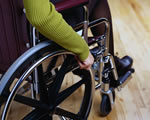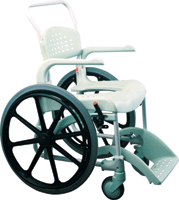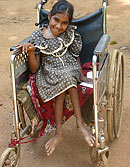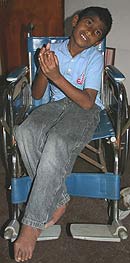
|
|||||||||||||
|
| |||||||||||||
A Quick Guide to Mobility Disability Solutions
Mobility EquipmentMany people with disabilities choose to use crutches, braces, canes or adaptive (orthotic) shoes. Individuals with upper limb disabilities may use adaptive equipment to assist with daily activities such as dressing or opening doors. People with limited handwriting ability may use a computer or typewriter instead of pen and paper. Generally people who need these devices already own them. However, participants from overseas may not have had access to some types of adaptive devices in their home country. Also, repairs or replacements for adaptive equipment may be difficult to get in some countries. Crutches and canes generally have replaceable rubber tips, which wear out over time. Depending on the length and location of the exchange, it may be a good idea for participants to bring an extra supply of crutch tips or cane tips with them during the exchange. If adaptive equipment breaks, it may not be possible to purchase identical replacements in the country being visited. Forearm crutches, for instance, may be difficult or impossible to obtain in some countries. Possible ways to address this include having participants bring extras of their adaptive equipment from home, arranging to ship replacements from home if necessary, or looking at the possibility of having equipment repaired locally (someone with welding equipment, for instance, may be able to repair crutches). If the specific adaptive equipment a person with a disability normally uses is not available in the host country, consider alternatives that are locally available, and what option best suits the person with a disability. Some people might prefer to use a different type of crutch or cane, others to make temporary use of a wheelchair, and still others to go without mobility aids temporarily. People with mobility disabilities who use walkers, crutches, canes, prostheses or other aids often have varying ability levels. They may be able to walk shorter distances unassisted, find it easier to walk on some days than others, or find navigating uneven, wet, slippery or cluttered walking surfaces more difficult to walk on than others. Heavy doors can difficult for anyone to manage, and people who use crutches, canes or walkers may have extra difficulties. Handrails are often particularly helpful to people who have difficulty walking. Note that handrails should be placed on both sides of a staircase or ramp because an individual may be stronger on one side of their body than the other. A "short distance" to a program site from a host family's home for a participant without a mobility disability can be prohibitive for those with reduced stamina or increased pain levels. Encourage participants to ask detailed questions about the location of overseas program activities so that they can anticipate potential barriers to participation and request alternative arrangements. Low cost taxi services are available in many areas and can take the form of a car, bicycle, boat, or scooter among others. These alternate forms of transportation can be extremely helpful for people with mobility disabilities, and can be used for trips over a moderate distance, which might otherwise be difficult. Exchange organizations should reach agreement with participants before a program begins about who will be responsible for repair or replacement costs. Some exchange organizations have also provided assistance with taxi fares in countries where the expense can add up and other transportation is not feasible. Environmental AdjustmentsSome people with disabilities may need to have tables or chairs adjusted for their use. To make tables higher, place blocks of wood under the legs. To lower tables or chairs, cut the legs down with a hand saw. Other disabled individuals may need to use a bed of a certain height. Try using a futon instead of a bed or placing the box springs and mattress on the floor rather than on a frame. Many people can benefit from these types of simple adaptations. Accessible Toilet FacilitiesAnother issue to consider is the availability of accessible toilet facilities. A portable commode can be an excellent solution to this problem. A commode can also double as a shower chair or a seat. Commodes can be rented or purchased through medical equipment suppliers. This simple adaptation can create improved access for people with physical disabilities who are willing to be flexible for the sake of adventure. Shower Chairs/Bath BenchesSome people with disabilities need to have extra support for showering. Shower chairs make it possible for many people with mobility disabilities to shower independently. Shower chairs and bath benches come in many shapes and sizes. Consult the individual who will be using the equipment for specific requirements. Luggage / BagsMany mobility aids require use of one or both hands, and make it difficult to carry objects and walk at the same time. People with a disability affecting their hands may have limited abilities to carry objects. Backpacks, shoulder bags, and other bags may be an important adaptation in these situations. Reminding participants with disabilities to bring bags or backpacks of whatever style works for them into different situations can be a simple way to provide accessibility. Personal AssistantsPersonal assistants or personal care assistants/attendants are individuals hired by some people with disabilities to help with everyday personal activities, such as dressing, bathing, bathroom needs, cooking, shopping and other household chores. At home, some disabled adults use assistants for difficult chores. For US citizens, many state and federal programs provide personal assistant services. Participants interested in hiring a personal assistant abroad may wish to contact individuals with disabilities and/or disability organizations in the host country for resources and suggestions. Local people with disabilities may be able to assist with identifying accessible lodging and transportation services as well. Most people with disabilities, including most wheelchair users, do not use personal assistants. Many people use electric wheelchairs because of weakness in their arms that prevents pushing a chair. These individuals can often complete everyday tasks without assistance. Guide Dogs and Service AnimalsThe option of entering into a partnership with an animal trained to provide services to assist a person with a disability is becoming increasingly common for people with a wide variety of disabilities. A service animal provides a person with a disability an opportunity to have round-the-clock access to the assistance they need in order to lessen the affect their disability has on daily life. An animal can adapt to environments, adjust how it performs its duties and respond to changes in its partner like no other piece of adaptive equipment can. Return to Top of Page
Lifting and TransferringFor many people being carried is an uncomfortable experience, both physically and in terms of dignity and independence. Lifting someone up stairs or around obstacles is not an acceptable alternative to appropriate accessibility measures. Most people prefer to be lifted only as a last resort. There may be times, however, when a person with a mobility disability may choose to tackle environmental barriers that require lifting or transferring. A proper lift and transfer should be a comfortable and safe experience for the lifter as well as the individual being lifted. Everyone involved must work together to ensure that all transfers will be comfortable and safe. The person being lifted should direct the lift, as he or she knows what will work best. The people lifting need to have a good understanding of safe lifting techniques, as well as specific instructions from the individual being lifted, to protect their own bodies. People with mobility disabilities generally do not benefit from being unexpectedly grabbed or steadied when they are attempting to balance. Often times, a person may be most capable of balancing when moving in a specific way, and having sudden weight on their shoulders, or being unexpectedly pushed in a certain direction may worsen their balance. It is best to ask before offering any assistance with standing, walking, rising, or other activities, and make it clear that the person can ask for assistance when they need it. If assisting with balance, take direction from the person being assisted about his/her specific needs and what works best. Many people do better if they can use the other person as a support rather than being held in another's grasp.
|





